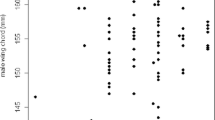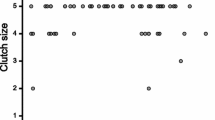Abstract.
Morphological, territorial, and behavioural characteristics were measured on white-bearded manakin ( Manacus manacus ) males from two leks in two consecutive years. These data were combined with data on marker-inferred relatedness to study possible co-variation with mating success. In one year, male size and male condition were correlated with mating success. In both years, males holding courts nearer the lek centre gained more matings. No observed male display behaviour appeared to be an independently important factor in explaining variance in male mating success. Successful males made more aggressive displays than non-successful males and more displays were between close relatives. Number of aggressive displays increased as the distance between male courts decreased. Mating success in the white-bearded manakin is most likely mediated by a combination of morphological and behavioural characteristics, influencing both male–male competition and female choice. Females could potentially use centrality on the lek as an indicator of male characteristics. However, levels of relatedness may influence spatial arrangement of males on a lek thereby affecting male–male interactions and ultimately influencing patterns of mating success.
Similar content being viewed by others
Author information
Authors and Affiliations
Additional information
Electronic Publication
Rights and permissions
About this article
Cite this article
Shorey, L. Mating success on white-bearded manakin (Manacus manacus) leks: male characteristics and relatedness. Behav Ecol Sociobiol 52, 451–457 (2002). https://doi.org/10.1007/s00265-002-0540-9
Received:
Revised:
Accepted:
Issue Date:
DOI: https://doi.org/10.1007/s00265-002-0540-9




